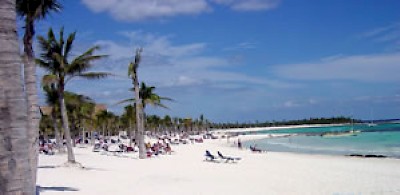Yucatan News: Gas Prices & more!
Yucatan Living Needs Your Support
>
As Yucatan Living grows, so do the stresses placed on our limited resources. What began as a simple blog has developed into a comprehensive community resource with a full time staff of computer personnel, researchers, and writers, all dedicated to assisting both expats and Yucatecos in their quest for useful information about living, working, and playing in Yucatan. The level of research, news-gathering, photography, and web hosting we are now doing is costly and we need the help of our readers to continue to bring you indepth articles about the topics that are of value to you. Please visit our "How to Sponsor Yucatan Living" page and become a part of helping to defray the costs of keeping this resource available.
Gasoline Prices in Mexico
For those of our local readers who may have forgotten the pain of the gas pump north of the border... and for our north of the border readers who may be considering a move here.... Working Gringo has calculated the cost of a gallon of gasoline in Mexico for February 2008 and for May 2008. This is for two reasons. First - so everyone will have an up to date "relative" price for gasoline in Mexico - and second - so that everyone can have a concrete example of the falling purchasing power of the U.S. dollar in other marketplaces. We have two grades of unleaded gasoline in Mexico: Magna (Regular) and Premium. The price of gasoline is controlled in Mexico and is the same throughout the entire country. The current 2008 price of Magna is $7.05 MXP per liter and the price of Premium is $8.77 MXP per liter. In February, 2008, the exchange rate was about $11 MXP to $1 USD. Magna was $2.42 per gallon and Premium was $3.02 per gallon. In May 2008, the exchange rate is now $10.5 MXP to $1 USD. This means that Magna is now $2.54 USD per gallon and Premium is $3.16 USD. ...all without the price of gasoline changing in actual pesos. We are beginning to see stories of American truckers crossing the border to fill their tanks and American tourists who are finding that a driving vacation is still affordable, so long as they vacation in Mexico. While even $2.54 USD per gallon seems like a great price to most folks who live north of the border, it is a signal to retiree expats that they may need to watch those pennies a little more carefully for a while.
Food Prices to Stop Rising in Mexico
"We can't sell it if people won't buy it" is the official and final opinion of Mexican food distribution companies, concerning the recent trend in rising food prices in Mexico. Therefore, the distributing companies have decided to hold food prices where they are. They are right. The people of Mexico and Yucatan will, at some point in time, simply stop buying in supermarkets and return to a completely local economy. There is almost nothing we could want for our kitchen that we cannot find grown right here in Yucatan - and at a much cheaper price than food that is shipped in from either Mexico or from the U.S. We have long been advocates of buying "Yucateco" and continue to encourage our readers to do so as much as possible.
Trotter's Wine
Last month, the Trotter Group, which owns Pancho's, La Tratto and Trotter's restaurants here in Merida, announced their own wine label. A private party was held at Trotter's restaurant to introduce a few hundred locals to the wine. After an introductory glass of champagne to get everyone in the mood, the two wines were paired with delicious food designed to enhance their flavors. Trotter's white wine is a Sauvignon Blanc and the red is a Cabernet Sauvignon - Cabernet Franc - Malbec - Merlot blend. In addition to a few short videos explaining that the wine comes from Argentina and that the project was done in conjunction with Covi, a local liquor store chain, the evening included instruction and entertainment by a female sommalier from Mexico City. Wearing a Madonna-like headpiece for her microphone, dressed all in black, the very attractive sommalier worked the room like a Las Vegas entertainer, educating and explaining about wine in general and these wines in particular.
The two wines are definitely worth drinking, and are available not only at the three restaurants mentioned above, but also at all Covi liquor stores (located throughout Merida and the Mayan Riviera. They even recently opened a storefront in the town of Tulum!).
Salud! Chin-chin! and all that! As refugees from California Wine Country, we're excited to see the Yucatan palate expanding it's horizons to include good wine.
Update: Chichen Itza International Airport at Kaua
For a long time, the new airport at Kaua, on the road between Valladolid and Chichen Itza, was considered to be a white elephant. Work continued on it, but no one seemed to be in a hurry to finish it and it began to fall into a state of disrepair. Then, Chichen Itza was voted one of the Seven New Wonders of the World and there was renewed interest in what was billed as the soon-to-be new international airport at Kaua. ...and that was the last anyone heard of it. Now, the State of Yucatan is buying 24.7% of the airport so they can get this long awaited and much needed project completed. So far, there have been two grand openings for the "new" airport at Kaua: April 12, 2000 and August 2007. Perhaps the next grand opening will finally give tourists a way to get into the interior of Yucatan without having to come in through Cancun or Merida and still face a long ride to their final destination.
Yet Another New Resort on the Mayan Riviera
The multinational corporation ING, according to Forbes.com, is getting ready to partner with Groupo Carrousel and Operadora Punta Maroma to build a $150 million dollar resort on Bahia Maroma on the Riviera Maya. There will be 86 villas, an ultra-luxury hotel with 127 rental units, an 18 hole Rees-Jones signature golf course, and a 10,000 sq ft clubhouse. The $150 million dollar price tag does not include the price of the waterfront property. No mention was made of how they propose to reduce the effect of such a massive footprint on the environment or how they plan to incorporate community development in their plans.
Hurricanes: Count Our Blessings
Every time we have a hurricane, we extoll the virtues of the Department of Civil Defense in Yucatan. This week, we found an MSNBC article that compares our hurricane experience with that of Myanmar, where tens of thousands of people died this past week - and more are starving with no way to reach clean water or food. That article specifically states that the reason we seldom, if ever, have a death during a hurricane in Yucatan is because our government has preventive measures in place at all times - and that the reason so many died in Myanmar is because their military government simply did not even warn them that the storm was coming. Our hearts go out to the people of Myanmar; and we would like to express our heartfelt thanks to all of those who work so tirelessly for our safety during hurricanes.
Red Cross Rescue & Cenote Ecotourism
This past week, the Red Cross put on an exhibition in Peto in which interested persons were shown how to rescue someone who has been injured inside a grotto or cenote. This is a timely subject because of our growing ecotourism and the sheer numbers of tourists who now enter geographical formations with which they may not be familiar. The exhibition included showing potential rescuers how to rappel down a "cliff" and how to use the equipment necessary to bring an injured person to safety. In this case, the "cliff" was the side of the Church of the Assumption in Peto, but the effect was the same. We want all of our tourists to feel that they are safe in Yucatan and that, should any emergency arise, qualified help is available.
Education, Unicef, and Mayan Traditions
Do you have a not-so-great educational system that seems to be falling apart? Why not adopt a new pattern, based on the quite successful educational traditions of the Mayans between the years 250 AD and 900 AD. Yucatan's Mayans did just that, with the help of the State and UNICEF, in 2001. The result is schools in which parents are extremely active and children who now speak not only Spanish and Mayan, but English as well. A full 60% of our population is Mayan, 24% of our people speak only Mayan - but 30% of our schools now teach both Mayan and Spanish. As a result of the "Child-Friendly Schools" program, each year, the number of Yucateco children who do not complete primary school is cut in half and the number of Yucatecos who grow up speaking Spanish, Mayan and English increases. Ethnic pride, community involvement and - most of all - parental involvement are responsible for these successes and we congratulate everyone along the way who recognized that this return to ancient, successful Mayan traditions in education would be the key to the future for the State of Yucatan. Who knows what the future will hold for these now bi- and even tri-lingual children - but we are willing to bet that theirs is going to be an amazing life!
>
Our Readers Asked About: Lebanese in Yucatan
Did you know... By 1948, there were 380 Lebanese families in Yucatan, along with 10 Syrian families and 6 Iraqui families?
We have been asked "How did the Lebanese get here and why did they come?" In order to answer that question, it is necessary to understand a little about the location of Lebanon and the political and religious situation in that area in the early to mid-1800s. First, we look at a map and find that the entire western border of Lebanon is on the coast of the Mediterranean Sea. That was pretty important during an era in which all transportation depended on caravans and ships. Whoever controlled the coast of the Mediterranean controlled the world, or at least that part of the world, and all that came in and out of it. Enter the Ottoman Empire, the Druze, and the Maronite Christians. The Ottoman Empire consisted of Muslims, Christians, and Jews - but, no matter their religion, the Ottomans all had an eye toward controlling the entire Mediterranean coastline, all the way to Jerusalem and beyond. The Druze were an offshoot of Islam and wanted to control Lebanon - but the Maronite Christians were gaining economic and social control in Lebanon. For a time, the Druze and the Maronites lived peacefully together in Lebanon.
Have you ever heard the old quote: The enemy of my enemy is my friend? That's what happened in Lebanon. The Ottomans pitted the Druze and Maronites against each other. The British supported the Druze and the French supported the Maronites, in keeping with the 1638 French promise to protect all Catholics in the Ottoman Empire. The situation worsened from 1840 until 1860 when full scale civil war broke out in Lebanon. The French finally stepped in and stopped the war, but not before over 10,000 Maronites lost their lives. Although still in a majority in Lebanon, many Maronite Christians were not satisfied with the new government and chose to migrate to the Americas. The greatest migration of Lebanese to Yucatan took place between 1880 and 1930, with many coming after that to join family members already here.
Today, we hardly think of Yucatecos who have Lebanese ancestry as being somehow "different," but such was not the case with the first generation here. To Yucatecos, all Lebanese were "Turks" and to the Lebanese, all Yucatecos were "Indians." That was all destined to change. The Lebanese easily converted to Catholicism because it was such a close parallel to their Maronite beliefs and practices. They also sent their children to public school and practiced the same level of loyalty, honor and family values that continues to be so dear to all Yucatecos. While the first generation tended to marry within their own group, the next generations did not. Soon, there were no more Turks and Indians. There were only Yucatecos.
The first Lebanese immigrant to Mexico was Father Boutros Raffoul, who came to Veracruz in 1878. The first Lebanese immigrant to Yucatan, in 1879, was Santiago Sauma. Almost all of the Lebanese immigrants to Yucatan were Maronite Christians who settled in the City of Merida where they excelled in commerce and demonstrated a considerable level of social mobility. By the mid-1900's, the descendents of Merida's Lebanese immigrants had risen to the middle and upper classes of Yucateco society, where they remain today, peppering life in the Yucatan with names like Chedraui, Chapur and Siqueff.










